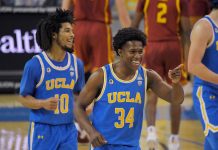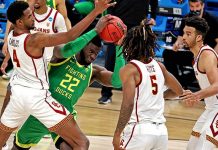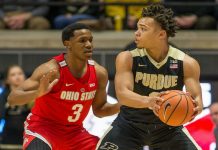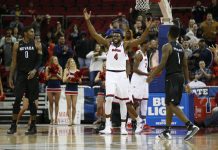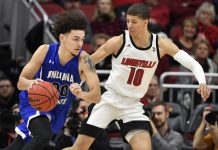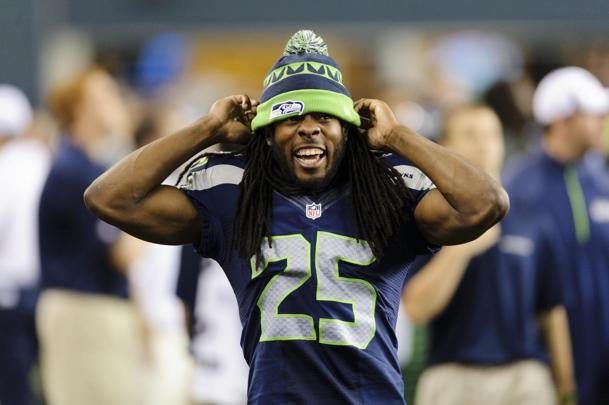NORTH ANDOVER, Mass. (AP) About 25 miles north of Boston, in a 1,500-seat gymnasium in a quiet nook just off State Route 125, Joe Gallo is busy teaching basketball.
Arms folded as he walks the length of the court, Gallo watches as a ball gets away from one of his players during a practice drill and ricochets off the bottom of the retractable bleachers.
“We don’t stop competing!” Gallo shouts. “Compete! Compete! Compete!”
Welcome to Merrimack College, home of one of the biggest surprises in college basketball this season.
After spending most of the program’s 70-year existence at the Division II level, the Warriors weren’t expected to be more than a blip in the NCAA’s top division in the first year of reclassifying.
That was underscored in the preseason when, despite coming off three straight Division II tournament appearances, the Northeast Conference coaches picked Merrimack to finish last among the league’s 11 schools.
The Warriors smashed those expectations in their season finale Thursday, clinching at least a share of the regular-season NEC championship with a 69-58 win over Central Connecticut. Merrimack (20-11) is the first school in NCAA history to win a regular-season conference title in its first Division I season. A loss by Saint Francis (Pa.) in its finale on Saturday would give the Warriors the championship outright. The Warriors’ 20 wins are also a record by a first-year reclassifying school.
The one thing Merrimack won’t have this season is a place in March Madness.
By NCAA rule, the Warriors are ineligible to compete in their conference tournament or the NCAA Tournament until they become full Division I members in the 2023-24 season. They are, however, eligible to play in the College Basketball Invitational or CollegeInsider.com Postseason Tournament.
Even with the NCAAs off the table, Gallo said his team remains excited for whatever is next.
“Each one of those steps along the way has been a different form of motivation,” Gallo said. “You know, at first it was, ‘Well, we’ll show we’re not just a Division II team.’ And then it was, ‘OK. These guys want to pick us last.’ … So there’s been a lot of milestones along the way that we’ve been able to use for motivation for these guys.”
New England’s only Catholic Augustinian college, Merrimack’s athletic programs began with men’s hockey in 1955, winning a Division II national title in 1978. But as Division II became more regionalized, the Division I programs like Boston College, Boston University and Northeastern were penalized for playing D-II teams.
Merrimack slowly grew to have 24 men’s and women’s varsity programs, though only the men’s and women’s hockey programs competed at the Division I level in Hockey East.
School leadership sought to change that and included in its 2011 strategic plan a goal to move all its programs into Division I. That opportunity arrived in 2018 when the NEC invited Merrimack’s non-hockey programs to become the league’s 11th member.
Christopher Hopey, who was appointed as Merrimack’s eighth president in 2010, said that leadership was looking for a way to build the school’s reputation and brand to help secure its long-term viability and health.
“You can build billboards, you can do advertising, that really isn’t going to really work,” Hopey said. “And actually, athletics became a really strong, identified institution and it kind of became a way of kind of showing folks what Merrimack was all about.”
Hopey said they aren’t worrying about having to break the bank to compete on the higher level because they already offered scholarships in D-II
“It wasn’t that much more money going Division I,” he said.
Coming off a conference tournament championship in the final season in Division II, Gallo went into the preseason believing his team could do well on the next level.
That perception took a hit when the Warriors opened the season with a 20-point loss at Maine.
Gallo, who played for Merrimack under coach Bert Hammel before succeeding him in 2016, remembers sleeping for about an hour that night. He pondered what had happened to the senior-driven, defensive-minded roster that had carried his team the previous three seasons.
Two nights later came a trip to face the Big Ten’s Northwestern.
The Warriors trailed 55-50 with 9 1/2 minutes remaining before using a 17-4 run to propel them to a 71-61 win.
Merrimack also beat Army, but struggled at times during a 6-7 start to the nonconference portion of the schedule. Things changed when they opened conference play by winning 10 of their first 11. They finished 14-4.
“You have ups. So you have downs. But like all those ups and downs, you become way stronger than you actually thought you would be,” senior point guard Juvaris Hayes said.
Merrimack ended its season allowing a league-low 60.2 points per game while forcing a league-best 17.4 turnovers. One of the biggest reasons was the play of Hayes, who had a league-high 121 steals. He ended his career with 457 steals, eclipsing the NCAA record that had stood for 17 years.
“It started when I was probably 10,” Hayes said. “I was always that kid you didn’t want to cross over in front of.”
Hayes has been supported by fellow seniors Jaleel Lord and Idris Joyner. The trio starred together at New Jersey’s famed St. Anthony High School, going 32-0 as seniors and winning a state championship together in 2016.
Lord said Gallo fostered an environment at Merrimack that allowed them to play with freedom, while stressing a defensive approach that focused on creating “panic” for opponents.
“He’s just always given us the bread crumbs and we just follow,” Lord said.
The Warriors’ success on the basketball court this season has already produced evidence that the alumni and community are taking notice. Merrimack averaged 461 fans in 15 home games in 2018-19. In 12 home games this season, Merrimack averaged 1,039 fans.
“It not the same little Merrimack that I went to,” Gallo said.
—
For more AP college basketball coverage: https://apnews.com/Collegebasketball and http://twitter.com/AP-Top25
25% Bonus via Western Union


